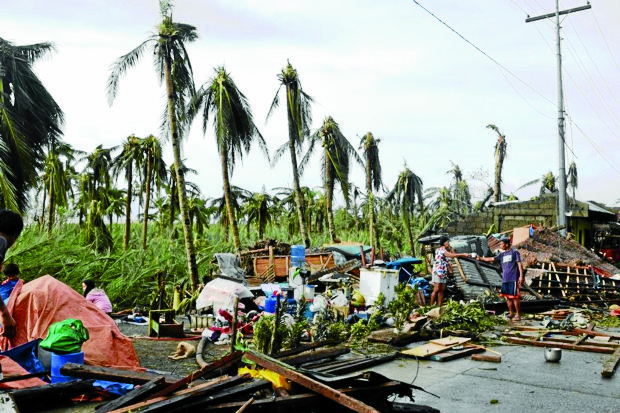‘Nina’ strongest typhoon to hit Bicol in 10 years

SCENE OF DESTRUCTION A woman shares a cup of hot coffee with her husband amid the ruins of their house a day after Typhoon “Nina” struck their village in Bato, Catanduanes province. Authorities reported at least seven deaths in the strongest typhoon to hit Bicol in 10 years. —FERNAN G. GIANAN
TIWI, ALBAY—The sight along the highway was anything but merry a day after Christmas: Wrecked houses in pools of mud, toppled electric posts and darkness engulfing the town as evening fell.
At least 50 percent of the houses in this town of 50,000 were wrecked by Typhoon “Nina” (international name: Nock-ten) in what Mayor Jaime Villanueva described as the strongest to strike the Bicol region in 10 years.
“We felt a stronger impact than we did when Typhoon ‘Reming’ hit us in 2006,” he said, referring to the howler internationally known as Durian.
Defense Secretary Delfin Lorenzana, who flew to Virac at noon on Tuesday, said the Catanduanes capital was devastated and it would take the province five to 10 years to recover from the destruction of its coconut and abaca plantations.
President Duterte made a quick visit to Virac and Pili in Camarines Sur on Tuesday. He refused to participate in the distribution of relief goods. “That style is rotten, I do not like that,” he said.
Article continues after this advertisementBut he promised to help the typhoon victims and urged them not to despair. “I hope you would recover your bearing,” he said.
Article continues after this advertisementThree more deaths were reported on Tuesday, bringing to eight the number of people killed in the typhoon that lashed the Philippines over the Christmas holidays with winds up to 235 kilometers per hour, the government said.
At least 18 others were reported missing after the MV Starlight Atlantic sank off Batangas on Monday, killing one.
Officials reported that Gregorio Tadeo, 60, was found dead in his house in Polangui, Albay; an 8-year-old boy drowned in Marinduque, and another fatality identified as Iraya Soledad Likdawan was reported in San Teodoro, Oriental Mindoro.
Power outages
Nina took out power in many eastern provinces, with energy officials unsure when electrical services would be restored, said Mina Marasigan, spokesperson for the National Disaster Risk Reduction and Management Council.
“We saw many houses destroyed by the strong winds. Infrastructure like schools and hospitals as well. We are still awaiting the exact figures of how many houses were destroyed, on the exact cost of damage,” Marasigan told reporters.
National Grid Corp. of the Philippines said it had restored nine of the 18 transmission lines downed by the typhoon. It said 10 crews had been mobilized to inspect and assess the damage.
More than 429,000 people were preemptively evacuated from their homes in vulnerable areas, official figures showed.
The typhoon had been expected to bring heavy rains and winds to Metro Manila, but it lost force as it plodded across southern Luzon. Nina had sustained winds of up to 105 kph and gusts of 130 kph when it blew into the South China Sea on Tuesday morning.
Nina was one of the strongest to hit the Philippines since Supertyphoon “Yolanda” (international name: Haiyan) left more than 7,300 people dead or missing and displaced more than 5 million in 2013.
But officials in some provinces found it difficult to convince people to abandon their Christmas celebrations and head for the shelters before the storm hit.
“Some residents just refused to leave their homes even when I warned them that you can face what amounts to a death penalty,” Cedric Daep, a top disaster official in Albay, said by phone.
Tens of thousands of villagers, forced to spend Christmas in crowded and powerless emergency shelters, started to return home on Monday to deal with the damage.
“They have left the evacuation centers and we’re seeing the sun again,” Ann Ongjoco, mayor of the town of Guinobatan in Albay, one of five provinces that lost electricity, said by phone.
Operations at Ninoy Aquino International Airport gradually returned to normal on Tuesday, a day after 364 flights were canceled.
The Civil Aviation Authority of the Philippines said some P9 million worth of damage was inflicted on the airports of Virac, Naga and Legazpi.
There is enough supply of milled rice in areas affected by Nina and stocks are ready for distribution “anytime,” according to the National Food Authority (NFA).
NFA officer in charge Tomas R. Escarez said in a statement the agency had well-stocked warehouses nationwide, especially in the regions of Bicol, Calabarzon and Metro Manila. —WITH REPORTS FROM CYNTHIA D. BALANA, DAXIM L. LUCAS, JAYMEE T. GAMIL, RONNEL W. DOMINGO, JEANNETTE I. ANDRADE, JUAN ESCANDOR, MARICAR CINCO, MAR S. ARGUELLES, MAL APRIL MIER, MADONNA T. VIROLA, MICHAEL JAUCIAN, DELFIN T. MALLARI AND FERNAN GIANAN, AP, AFP